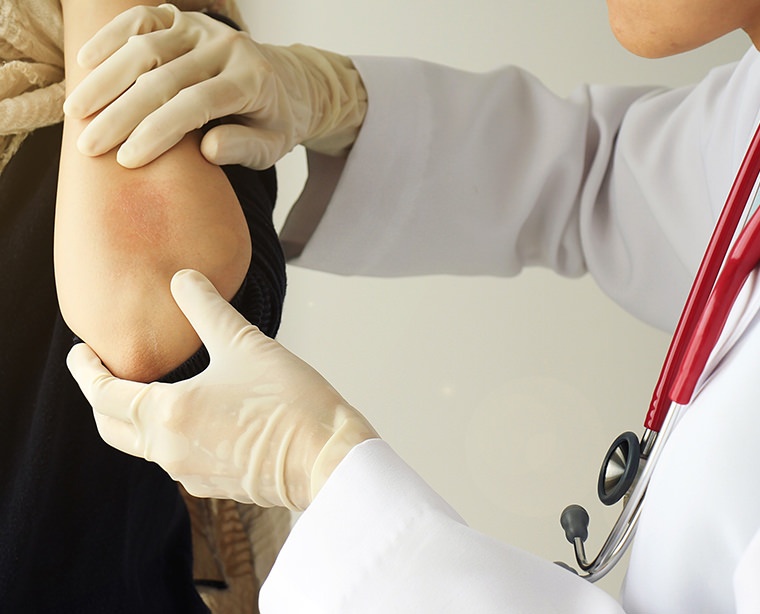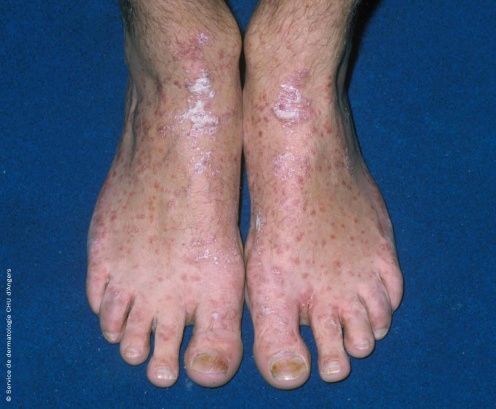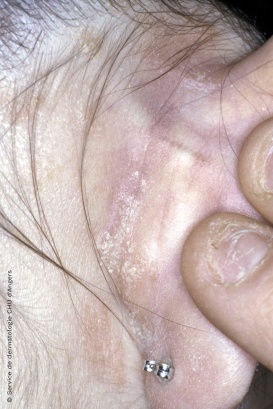

Eczema versus psoriasis: how to tell the difference

Most often, the different appearance of the patches and lesions provides a visual distinction. In some cases, however, eczema and psoriasis can be easily confused...
Key characteristics that distinguish the two diseases
Similarly to eczema, psoriasis is a hereditary chronic inflammatory disease presenting as itchy red patches in alternating periods of flare-ups and remission. So, what makes psoriasis different?
Unlike eczema, psoriasis is linked to accelerated skin regeneration. More specifically, keratinocyte cells regenerate in just 7 days (instead of 21). Plus, the normal maturation process of these cells is disrupted. This causes the skin to thicken around the patches and to peel more than usual.
Psoriasis patches appear in different areas of the body than eczema patches. The areas most often affected by psoriasis are the elbows, the front of the knees, the upper buttocks, and the scalp. The fingernails and hands are often affected as well. Psoriasis may even cover the entire body.
There is a particular form of psoriasis that affects the skin folds, appearing mostly on the folds in the groin, underarms and the navel.
How can you tell whether you have eczema or psoriasis?
The two diseases are very different, but they have some similarities that can make it difficult to tell them apart. This is particularly true for certain areas of the body, like the hands, or when the disease covers the entire body.
Neither one is contagious, which is another point they have in common.
There is usually a clear visual distinction, however. For psoriasis:
- the patches have a much brighter red tone;
- the lesions have much clearer more well-defined edges;
- the patches are thicker and covered in thick, white scales.
The following additional signs may indicate psoriasis:
- Psoriasis is very rare in infants, but when it does affect this age group, it appears in the diaper area as bright red, well-defined patches with no scaling.
- Psoriasis can appear in children. Often, the outbreak is preceded by an infection, and the patches are spread out over the body: “guttate psoriasis”.
- In adults, psoriasis affects different areas of the body, particularly:
- the front of the knees (and not the back of the knees as with eczema)
- the elbows (and not the elbow folds like with eczema)
- the buttocks
- the scalp, appearing as “dry dandruff”
- on the fingernails, giving them a thicker or “dented” appearance.
- Psoriasis often runs in families.
How to care for your skin
The first step is to see a doctor. A “DIY-diagnosis” is unable to distinguish eczema from psoriasis reliably. Plus, you could have another condition altogether (scabies, mycosis, herpes, etc.) which could even be contagious!
Treatment for eczema
Topical corticosteroids (cortisone creams) are used systematically to soothe itching. As for complementary care, the recommendations vary depending on the condition (allergic eczema vs. atopic eczema).
Treatment for psoriasis
Topical corticosteroids are also used to fight skin inflammation and are available in various formats, including ointments for thick patches, and creams and lotions for the scalp and skin folds. They are often combined with vitamin D3 analogues to slow down the proliferation and maturation of those excess keratinocytes. Various complementary care solutions are also recommended, such as hydrating products and specific shampoos.
Treatments are also provided in the form of tablets, injections or even phototherapy for more severe forms of psoriasis.









